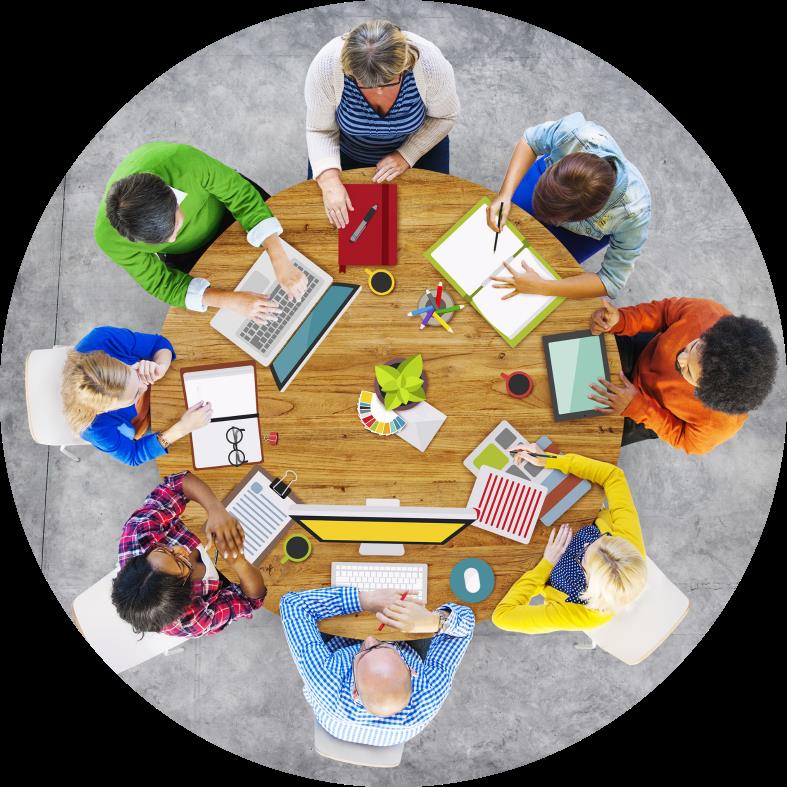
Cooperative learning strategies have proven to be highly effective in engaging learners and promoting active participation in the classroom.
In this article, we will explore ten superb strategies that foster collaboration and enhance learning outcomes.
From the Jigsaw Strategy to the Rotating Review, these techniques create an inclusive and dynamic learning environment where students have the freedom to exchange ideas and support each other's growth.
Join us as we delve into these powerful strategies and unlock the full potential of cooperative learning.
Jigsaw Strategy
The Jigsaw Strategy is a highly effective cooperative learning approach that promotes active engagement and collaborative problem solving among learners. Inspired by the concept of a jigsaw puzzle, this strategy involves dividing learners into small groups.
Each group is then assigned a specific piece of information or task related to the overall topic or problem. Each group member becomes an 'expert' on their assigned piece and then regroups with members from other groups who have the same piece.
In these mixed groups, learners share their expertise and work together to complete the puzzle. This strategy encourages learners to actively participate, communicate, and rely on each other's knowledge, fostering a sense of interdependence and cooperation.

Through this collaborative process, learners develop a deeper understanding of the topic while honing their problem-solving and communication skills.
Think-pair-share
One effective cooperative learning strategy that builds on the principles of active engagement and collaboration is the think-pair-share technique.
This technique involves students first thinking about a question or problem individually, then pairing up with a classmate to discuss their thoughts and ideas, and finally sharing their findings with the whole class.
Think-pair-share encourages active participation, as it gives every student an opportunity to engage in the learning process. Through pair discussion, students can exchange ideas, challenge each other's thinking, and develop their understanding of the topic.
This collaborative learning approach not only promotes critical thinking and problem-solving skills but also fosters a sense of community and teamwork within the classroom.
Round Robin Brainstorming
Round Robin Brainstorming is an effective group brainstorming technique that enhances collaboration among learners.
This technique involves each member of the group taking turns to contribute ideas or solutions to a problem or question.

Effective Group Brainstorming Techniques
Engaging learners in cooperative learning requires the effective utilization of group brainstorming techniques, such as employing the round robin method. This technique not only promotes active participation but also enhances the overall effectiveness of group facilitation.
Here are some reasons why round robin brainstorming is an effective group brainstorming technique:
- Encourages equal participation: Round robin ensures that all group members have an equal opportunity to contribute their ideas, preventing dominant individuals from monopolizing the discussion.
- Fosters a non-judgmental environment: By allowing each participant to share their thoughts without criticism or evaluation, round robin creates a safe space where learners feel free to express themselves.
- Stimulates creativity and diversity: This technique encourages learners to build upon each other's ideas, leading to a richer and more diverse range of solutions.
- Enhances listening skills: Round robin necessitates active listening as learners need to pay attention to others' ideas in order to build upon them effectively.
Enhancing Collaboration Through Brainstorming
The use of an effective brainstorming technique known as round robin can greatly enhance collaboration among learners in cooperative learning settings. Round robin brainstorming is a collaborative ideation process that encourages equal participation and interactive brainstorming among all group members.
This technique involves each member of the group contributing their ideas in a sequential and organized manner. Starting with one member, each person takes turns sharing their ideas while others actively listen and build upon them.
This fosters a sense of inclusivity and encourages all learners to actively engage in the brainstorming process. By incorporating round robin brainstorming into cooperative learning settings, learners have the opportunity to collaborate, exchange ideas, and collectively generate innovative solutions.
This interactive brainstorming technique promotes open communication, teamwork, and creativity among learners, creating a dynamic and engaging learning environment.
Three-Step Interview
The Three-Step Interview is a cooperative learning strategy that offers several benefits for engaging learners.

Firstly, it promotes active listening and communication skills as students take turns interviewing and responding to each other's questions.
Secondly, it encourages critical thinking as learners analyze and reflect on the information shared during the interview process.
Additionally, there are variations of the Three-Step Interview that can be adapted to different subjects and classroom settings, making it a versatile strategy for enhancing student engagement and participation.
Benefits of Three-Step Interview
Three-Step Interview's benefits include enhancing learners' collaboration and critical thinking skills. This cooperative learning strategy encourages active participation and engagement among students, fostering a sense of ownership over their learning process.
The benefits of Three-Step Interview can be summarized as follows:
- Improved Communication: By engaging in structured interviews, students develop effective communication skills, including active listening and asking thoughtful questions.
- Enhanced Collaboration: Working in small groups allows students to share ideas, perspectives, and knowledge, leading to the development of a collective understanding.
- Critical Thinking Development: Three-Step Interview promotes critical thinking by encouraging students to analyze information, evaluate perspectives, and construct well-reasoned responses.
- Increased Engagement: This strategy promotes student engagement as learners take responsibility for their learning and actively participate in discussions.
Variations of Three-Step Interview
Variations within the Three-Step Interview method offer educators diverse approaches to engage learners in collaborative learning activities.
These variations provide effective strategies that can be tailored to the specific needs and preferences of both the teacher and the students.

One variation is the 'Inside-Outside Circle' where students form two concentric circles and take turns interviewing each other. This variation encourages active participation and peer interaction.
Another variation is the 'Round-Robin' approach, where students form small groups and take turns interviewing each other, ensuring equal participation and engagement.
The 'Speed Dating' variation allows students to rotate and interview multiple partners in a limited time, fostering quick thinking and concise communication skills.
These variations of the Three-Step Interview method provide educators with flexible options to effectively engage learners and promote collaborative learning.
Learning Together Model
The effectiveness of the Learning Together Model's cooperative learning strategies has been widely acknowledged by educators. This model emphasizes the importance of learning partnerships and encourages students to work collaboratively towards a common goal. The Learning Together Model utilizes various cooperative learning techniques to engage learners and promote active participation in the learning process.
The use of group discussions allows students to exchange ideas and perspectives, fostering critical thinking and the exploration of different viewpoints.
Peer tutoring enables students to learn from and teach one another, enhancing understanding and retention of knowledge.

Collaborative projects encourage teamwork and the development of important interpersonal skills, such as communication and problem-solving.
The inclusion of cooperative games and activities creates a positive and enjoyable learning environment, increasing motivation and engagement.
Numbered Heads Together
Implementing the cooperative learning strategy of Numbered Heads Together enhances student engagement and participation in the classroom. This strategy involves assigning a number to each student in a group and then posing a question or problem for the group to solve. Students must work together to discuss and find the solution. Once the group has reached a consensus, the teacher randomly selects a number, and the student with that number must provide the group's answer.
This strategy promotes active listening, critical thinking, and collaboration among students. It also ensures that every student in the group is accountable for their learning. By incorporating Numbered Heads Together into the classroom, educators create an inclusive and interactive learning environment that empowers students to take ownership of their education.
Team Pair Solo
A highly effective cooperative learning strategy for engaging learners is through the use of the Team Pair Solo approach. This method involves three stages: team collaboration, pair discussion, and individual reflection.
- Team Collaboration: Students work together in small groups to solve a problem or complete a task. This promotes teamwork, communication, and the sharing of ideas.
- Pair Discussion: After the team collaboration phase, students pair up to discuss their findings or solutions. This allows for deeper understanding and the opportunity to clarify any misconceptions.
- Individual Reflection: Finally, students engage in independent reflection, where they analyze their own learning and identify areas for improvement. This fosters critical thinking and self-awareness.
The Team Pair Solo approach combines the benefits of both collaborative learning and individual reflection, providing students with a well-rounded learning experience that promotes engagement, autonomy, and personal growth.
Circle the Sage
One effective cooperative learning strategy for engaging learners is through the implementation of the Circle the Sage approach.

This strategy involves students forming a circle, with one student designated as the 'sage' or expert. The sage is responsible for sharing their knowledge and expertise on a specific topic, while the other students ask collaborative questions and engage in discussions to deepen their understanding.
This approach not only encourages active participation and engagement among learners but also promotes critical thinking and problem-solving skills. By facilitating discussions and encouraging collaborative questioning, the Circle the Sage approach allows students to learn from their peers and build upon each other's ideas.
This strategy empowers learners by giving them the freedom to explore different perspectives and develop a deeper understanding of the subject matter.
Partners
The cooperative learning strategy of working in partners fosters collaborative engagement and enhances learning outcomes. When students work together in cooperative partnerships, they have the opportunity to share ideas, ask questions, and support one another in their learning journey. Effective partner learning not only promotes academic growth but also helps develop important social and communication skills.
Here are four reasons why working in pairs can be a powerful learning strategy:
- Increased engagement: Partner work encourages active participation and keeps students invested in the learning process.
- Improved understanding: Discussing concepts with a partner allows for deeper comprehension and the opportunity to clarify any misunderstandings.
- Enhanced problem-solving skills: Collaborating with a partner promotes critical thinking and the ability to consider different perspectives.
- Boosted confidence: Working with a partner fosters a safe and supportive environment, boosting students' confidence to take risks and contribute to discussions.
Working in partners offers a dynamic and interactive learning experience, empowering students to take ownership of their education while enjoying the freedom to explore and grow together.
Rotating Review
Rotating Review is a highly effective cooperative learning strategy that offers numerous benefits for learners. By rotating through different groups, students have the opportunity to review and consolidate their understanding of the material from multiple perspectives.

This strategy also encourages active participation and engagement, as learners take turns explaining concepts and providing feedback to their peers. Implementing Rotating Review can help foster a collaborative and supportive learning environment, where students can deepen their understanding through meaningful interactions with their classmates.
Benefits of Rotating Review
With the implementation of a rotating review strategy, learners can actively engage in the reinforcement of knowledge through collaborative learning experiences. This approach offers several benefits for learners:
- Enhanced retention: Rotating review allows learners to revisit previously learned information, reinforcing their understanding and retention of the content.
- Active participation: By actively participating in the review process, learners become more engaged and involved in their own learning experience.
- Peer interaction: Collaborative learning through rotating review encourages peer interaction, fostering a sense of community and promoting the exchange of ideas and perspectives.
- Varied perspectives: Rotating review provides learners with the opportunity to hear different viewpoints and approaches from their peers, expanding their understanding and promoting critical thinking skills.
Implementing Rotating Review
To effectively implement the rotating review strategy, educators can begin by structuring collaborative learning experiences that actively engage learners in the reinforcement of knowledge.
This can be accomplished by dividing students into small groups and assigning each group a specific topic or concept to review.
Each group will then rotate through different stations, where they will engage in activities such as discussions, quizzes, or hands-on projects related to their assigned topic.
This approach not only encourages active participation and peer learning, but also allows students to take ownership of their learning and develop a deeper understanding of the material.
Frequently Asked Questions
How Can the Jigsaw Strategy Be Adapted for Online Learning Environments?
Adapting the jigsaw strategy for virtual classrooms is an effective way to enhance student engagement in online learning. By dividing students into small groups and assigning them specific topics, they can collaborate and share their knowledge effectively, fostering a sense of responsibility and teamwork.

What Are Some Potential Challenges or Drawbacks of Using the Think-Pair-Share Method?
Some potential challenges or drawbacks of using the think-pair-share method include unequal participation, limited time for discussion, and the possibility of off-topic conversations. These factors can hinder the effectiveness of the strategy in engaging learners.
Can Round Robin Brainstorming Be Effective for Large Groups of Learners?
Round robin brainstorming can be an effective strategy for engaging large groups of learners. It allows for equal participation and encourages collaboration, idea sharing, and active involvement, resulting in a more dynamic and inclusive learning environment.
How Can the Three-Step Interview Technique Be Modified for Learners With Special Needs?
Modifying the three-step interview technique for learners with special needs requires adapting the process to accommodate their unique abilities and challenges. Effective strategies for engaging these learners include providing visual supports, incorporating multisensory activities, and offering individualized support and accommodations.
Are There Any Specific Resources or Materials That Are Recommended for Implementing the Learning Together Model?
Recommended resources and materials for implementing the learning together model include collaborative tools such as Google Docs and Padlet, as well as visual aids like graphic organizers and posters. These resources enhance engagement and facilitate effective group work.
 Family Craft ProjectsHome ImprovementCooking and BakingReuse and RecycleDIY GiftsEco-Friendly ProjectsDIY Home SolutionsSeasonal ActivitiesFun and GamesLearn TogetherPrivacy PolicyTerms And Conditions
Family Craft ProjectsHome ImprovementCooking and BakingReuse and RecycleDIY GiftsEco-Friendly ProjectsDIY Home SolutionsSeasonal ActivitiesFun and GamesLearn TogetherPrivacy PolicyTerms And Conditions

 Family Craft ProjectsHome ImprovementCooking and BakingReuse and RecycleDIY GiftsEco-Friendly ProjectsDIY Home SolutionsSeasonal ActivitiesFun and GamesLearn TogetherPrivacy PolicyTerms And Conditions
Family Craft ProjectsHome ImprovementCooking and BakingReuse and RecycleDIY GiftsEco-Friendly ProjectsDIY Home SolutionsSeasonal ActivitiesFun and GamesLearn TogetherPrivacy PolicyTerms And Conditions
